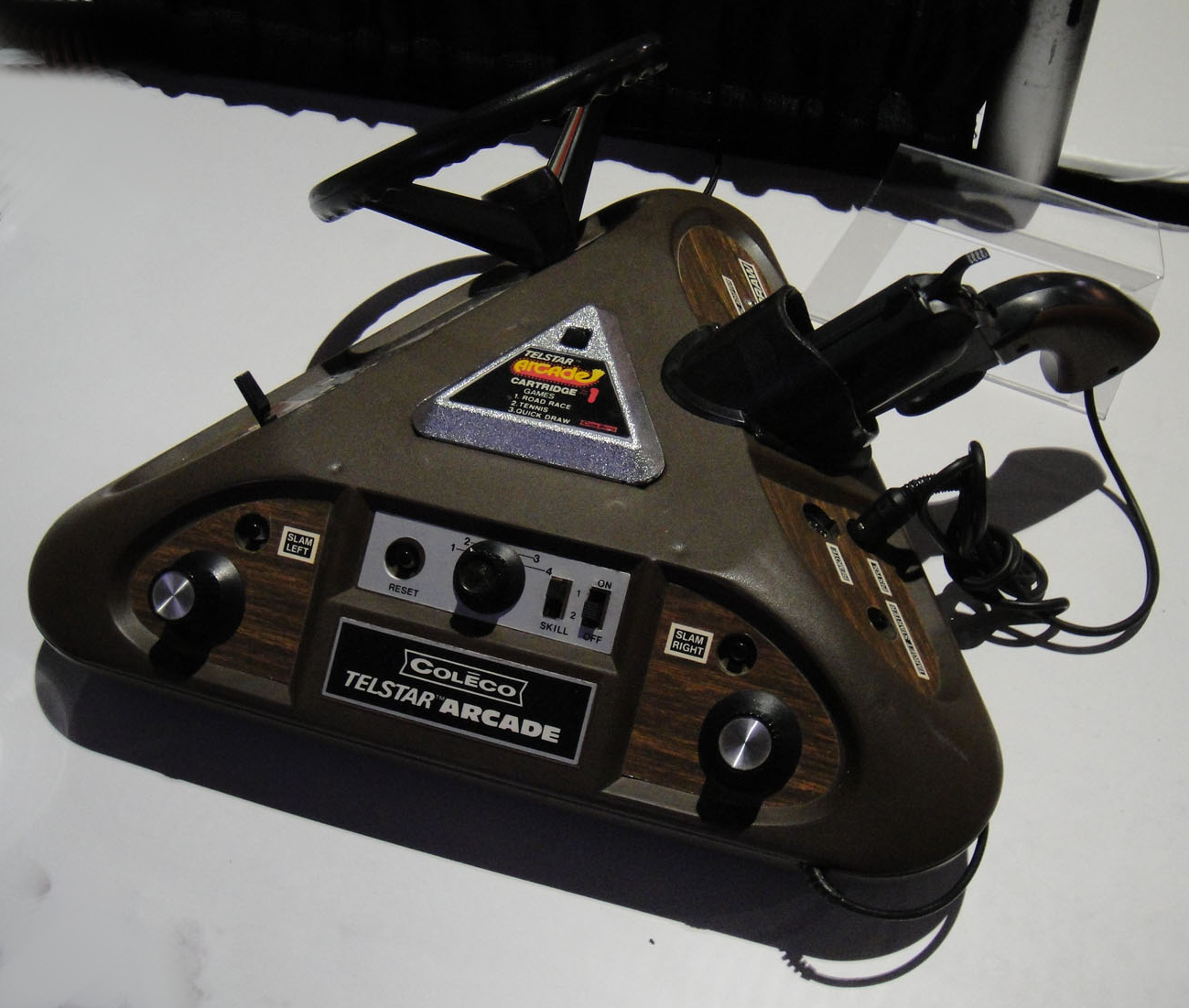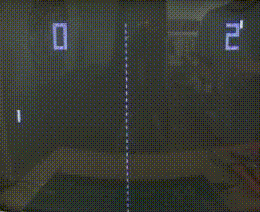|
Coleco Telstar Arcade
The Coleco Telstar Arcade, commonly abbreviated as Telstar Arcade, is a first-generation home video game console that was released in 1977 in Japan, North America and Europe by Coleco. It is the most advanced video game console in the Coleco Telstar series, based on the MOS Technology MPS-7600-00x chips series. Each chip is a microcontroller capable of storing 512 words of ROM. Construction and concept The Coleco Telstar Arcade is formed like a triangle. On every side are other game-specific controls. There is a side with a steering wheel and a lever, a side with a lightgun A light gun is a pointing device for computers and a control device for arcade and video games, typically shaped to resemble a pistol. Early history The first light guns were produced in the 1930s, following the development of light-sensing ..., and a side with two paddles. Depending on the game played, the player may use another side. Games The games came on silver-colored cartridges, each ... [...More Info...] [...Related Items...] OR: [Wikipedia] [Google] [Baidu] |
Coleco
Coleco Industries, Inc. was an American company founded in 1932 by Maurice Greenberg as The Connecticut Leather Company. It was a successful toy company in the 1980s, mass-producing versions of Cabbage Patch Kids dolls and its video game consoles, the Coleco Telstar dedicated consoles and ColecoVision. While the company ceased operations in 1988 as a result of bankruptcy, the Coleco brand was revived in 2005, and remains active to this day. Overview Coleco Industries, Inc. began in 1932 as The Connecticut Leather Company. The business supplied leather and "shoe findings" (the supplies and paraphernalia of a shoe repair shop) to shoe repairers. In 1938, the company began selling rubber footwear. During World War II demand for the company's supplies increased and by the end of the war, the company was larger and had expanded into new and used shoe machinery, hat cleaning equipment and marble shoeshine stands. By the early 1950s, and thanks to Maurice Greenberg's son, Leonard G ... [...More Info...] [...Related Items...] OR: [Wikipedia] [Google] [Baidu] |
Pong
''Pong'' is a table tennis–themed twitch arcade sports video game, featuring simple two-dimensional graphics, manufactured by Atari and originally released in 1972. It was one of the earliest arcade video games; it was created by Allan Alcorn as a training exercise assigned to him by Atari co-founder Nolan Bushnell, but Bushnell and Atari co-founder Ted Dabney were surprised by the quality of Alcorn's work and decided to manufacture the game. Bushnell based the game's concept on an electronic ping-pong game included in the Magnavox Odyssey, the first home video game console. In response, Magnavox later sued Atari for patent infringement. ''Pong'' was the first commercially successful video game, and it helped to establish the video game industry along with the Magnavox Odyssey. Soon after its release, several companies began producing games that closely mimicked its gameplay. Eventually, Atari's competitors released new types of video games that deviated from ''Pong' ... [...More Info...] [...Related Items...] OR: [Wikipedia] [Google] [Baidu] |
Video Games Developed In The United States
Video is an electronic medium for the recording, copying, playback, broadcasting, and display of moving visual media. Video was first developed for mechanical television systems, which were quickly replaced by cathode-ray tube (CRT) systems which, in turn, were replaced by flat panel displays of several types. Video systems vary in display resolution, aspect ratio, refresh rate, color capabilities and other qualities. Analog and digital variants exist and can be carried on a variety of media, including radio broadcast, magnetic tape, optical discs, computer files, and network streaming. History Analog video Video technology was first developed for mechanical television systems, which were quickly replaced by cathode-ray tube (CRT) television systems, but several new technologies for video display devices have since been invented. Video was originally exclusively a live technology. Charles Ginsburg led an Ampex research team developing one of the first practi ... [...More Info...] [...Related Items...] OR: [Wikipedia] [Google] [Baidu] |
1977 Video Games
Events January * January 8 – 1977 Moscow bombings, Three bombs explode in Moscow within 37 minutes, killing seven. The bombings are attributed to an Armenian separatist group. * January 10 – Mount Nyiragongo erupts in eastern Zaire (now the Democratic Republic of the Congo). * January 17 ** 49 marines from the and are killed as a result of a collision in Barcelona harbour, Spain. * January 18 ** Scientists identify a previously unknown Bacteria, bacterium as the cause of the mysterious Legionnaires' disease. ** Australia's worst Granville rail disaster, railway disaster at Granville, a suburb of Sydney, leaves 83 people dead. ** SFR Yugoslavia Prime minister Džemal Bijedić, his wife and 6 others are killed in a plane crash in Bosnia and Herzegovina. * January 19 – An Ejército del Aire CASA C-207 Azor, CASA C-207C Azor (registration T.7-15) plane crashes into the side of a mountain near Chiva, Valencia, Chiva, on approach to Valencia Airport in Spain, killing all ... [...More Info...] [...Related Items...] OR: [Wikipedia] [Google] [Baidu] |
Pong Variations
''Pong'' is a table tennis–themed twitch arcade sports video game, featuring simple two-dimensional graphics, manufactured by Atari and originally released in 1972. It was one of the earliest arcade video games; it was created by Allan Alcorn as a training exercise assigned to him by Atari co-founder Nolan Bushnell, but Bushnell and Atari co-founder Ted Dabney were surprised by the quality of Alcorn's work and decided to manufacture the game. Bushnell based the game's concept on an electronic ping-pong game included in the Magnavox Odyssey, the first home video game console. In response, Magnavox later sued Atari for patent infringement. ''Pong'' was the first commercially successful video game, and it helped to establish the video game industry along with the Magnavox Odyssey. Soon after its release, several companies began producing games that closely mimicked its gameplay. Eventually, Atari's competitors released new types of video games that deviated from ''Pong'''s ... [...More Info...] [...Related Items...] OR: [Wikipedia] [Google] [Baidu] |
Products Introduced In 1977
Product may refer to: Business * Product (business), an item that serves as a solution to a specific consumer problem. * Product (project management), a deliverable or set of deliverables that contribute to a business solution Mathematics * Product (mathematics) Algebra * Direct product Set theory * Cartesian product of sets Group theory * Direct product of groups * Semidirect product * Product of group subsets * Wreath product * Free product * Zappa–Szép product (or knit product), a generalization of the direct and semidirect products Ring theory * Product of rings * Ideal operations, for product of ideals Linear algebra * Scalar multiplication * Matrix multiplication * Inner product, on an inner product space * Exterior product or wedge product * Multiplication of vectors: ** Dot product ** Cross product ** Seven-dimensional cross product ** Triple product, in vector calculus * Tensor product Topology * Product topology Algebraic topology * Cap product * Cup product ... [...More Info...] [...Related Items...] OR: [Wikipedia] [Google] [Baidu] |
1977 In Video Gaming
1977 had sequels such as '' Super Speed Race'' and '' Datsun 280 ZZZAP'' as well as several new titles such as '' Space Wars''. The year's highest-grossing arcade games were '' F-1'' and '' Speed Race DX'' in Japan, and '' Sea Wolf'' and ''Sprint 2'' in the United States. The year's best-selling home system was Nintendo's Color TV-Game, which was only sold in Japan. Financial performance Highest-grossing arcade games Japan In Japan, the following titles were the highest-grossing arcade games of 1977, according to the second annual '' Game Machine'' chart. Both arcade video games and electro-mechanical games (EM games) are listed on the same arcade chart. Namco's EM racing game '' F-1'' was the highest-grossing overall arcade game for the second year in a row, followed by Taito's racing video game '' Speed Race DX'' (its predecessor '' Speed Race'' was distributed as ''Wheels'' by Midway Manufacturing in North America). Note: Medal games are listed on a separate chart, ... [...More Info...] [...Related Items...] OR: [Wikipedia] [Google] [Baidu] |
1970s Toys
Year 197 ( CXCVII) was a common year starting on Saturday (link will display the full calendar) of the Julian calendar. At the time, it was known as the Year of the Consulship of Magius and Rufinus (or, less frequently, year 950 ''Ab urbe condita''). The denomination 197 for this year has been used since the early medieval period, when the Anno Domini calendar era became the prevalent method in Europe for naming years. Events By place Roman Empire * February 19 – Battle of Lugdunum: Emperor Septimius Severus defeats the self-proclaimed emperor Clodius Albinus at Lugdunum (modern Lyon). Albinus commits suicide; legionaries sack the town. * Septimius Severus returns to Rome and has about 30 of Albinus's supporters in the Senate executed. After his victory he declares himself the adopted son of the late Marcus Aurelius. * Septimius Severus forms new naval units, manning all the triremes in Italy with heavily armed troops for war in the East. His soldiers embark on a ... [...More Info...] [...Related Items...] OR: [Wikipedia] [Google] [Baidu] |
Coleco Consoles
Coleco Industries, Inc. was an American company founded in 1932 by Maurice Greenberg as The Connecticut Leather Company. It was a successful toy company in the 1980s, mass-producing versions of Cabbage Patch Kids dolls and its video game consoles, the Coleco Telstar dedicated consoles and ColecoVision. While the company ceased operations in 1988 as a result of bankruptcy, the Coleco brand was revived in 2005, and remains active to this day. Overview Coleco Industries, Inc. began in 1932 as The Connecticut Leather Company. The business supplied leather and "shoe findings" (the supplies and paraphernalia of a shoe repair shop) to shoe repairers. In 1938, the company began selling rubber footwear. During World War II demand for the company's supplies increased and by the end of the war, the company was larger and had expanded into new and used shoe machinery, hat cleaning equipment and marble shoeshine stands. By the early 1950s, and thanks to Maurice Greenberg's son, Leonard Gree ... [...More Info...] [...Related Items...] OR: [Wikipedia] [Google] [Baidu] |
Paddle (game Controller)
A paddle is a game controller with a round ''wheel'' and one or more ''fire buttons'', where the wheel is typically used to control movement of the player object along one axis of the video screen. A paddle controller rotates through a fixed arc (usually about 330 degrees); it has a stop at each end. Design The paddle wheel is usually mechanically coupled to a potentiometer, so as to generate an output voltage level varying with the wheel's angle relative to a fixed reference position. A paddle is thus an absolute position controller. That is, without any previous knowledge, the sensor can be read and the result directly indicates the position of the paddle knob. This is in contrast to a rotary encoder-based device or "spinner". Where employed Paddles first appeared in video arcade games with Atari Inc.'s ''Pong'' in 1972, while the first console to use paddles was Magnavox's Odyssey that same year. The Apple II shipped with paddles until 1980. The Atari 2600 used paddles fo ... [...More Info...] [...Related Items...] OR: [Wikipedia] [Google] [Baidu] |
Home Video Game Console
A home video game console is a video game console that is designed to be connected to a display device, such as a television, and an external power source as to play video games. Home consoles are generally less powerful and customizable than personal computers, designed to have advanced graphics abilities but limited memory and storage space to keep the units affordable. While initial consoles were dedicated units with only a few games fixed into the electronic circuits of the system, most consoles since support the use of swappable game media, either through game cartridges, optical discs, or through digital distribution to internal storage. There have been numerous home video game consoles since the first commercial unit, the Magnavox Odyssey in 1972. Historically these consoles have been grouped into generations lasting each about six years based on common technical specifications. As of 2021, there have been nine console generations, with the current leading manufactu ... [...More Info...] [...Related Items...] OR: [Wikipedia] [Google] [Baidu] |
Light Gun
A light gun is a pointing device for computers and a control device for arcade and video games, typically shaped to resemble a pistol. Early history The first light guns were produced in the 1930s, following the development of light-sensing vacuum tubes. In 1936, the technology was introduced in arcade shooting games, beginning with the Seeburg Ray-O-Lite. These games evolved throughout subsequent decades, culminating in Sega's ''Periscope'', released in 1966 as the company's first successful game, which requires the player to target cardboard ships. ''Periscope'' is an early electro-mechanical game, and the first arcade game to cost one quarter per play. Sega's 1969 game ''Missile'' features electronic sound and a moving film strip to represent the targets on a projection screen, and its 1972 game ''Killer Shark'' features a mounted light gun with targets whose movement and reactions are displayed using back image projection onto a screen. Nintendo released the Be ... [...More Info...] [...Related Items...] OR: [Wikipedia] [Google] [Baidu] |







